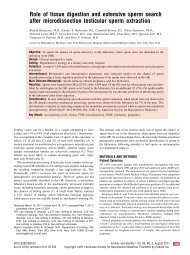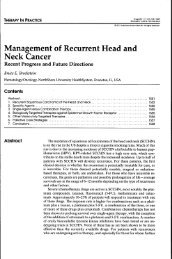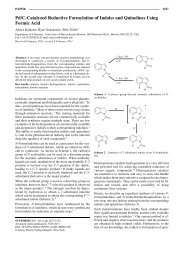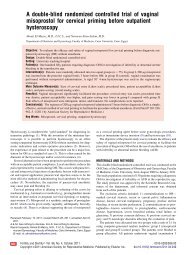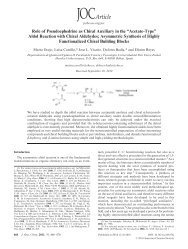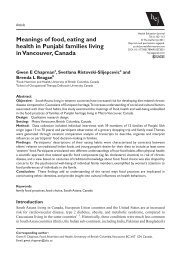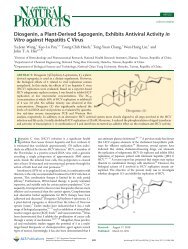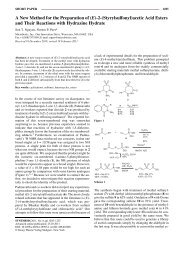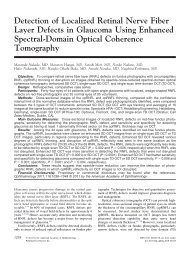Development of a Depth-Integrated Sample Arm to Reduce Solids ...
Development of a Depth-Integrated Sample Arm to Reduce Solids ...
Development of a Depth-Integrated Sample Arm to Reduce Solids ...
Create successful ePaper yourself
Turn your PDF publications into a flip-book with our unique Google optimized e-Paper software.
Selbig and Bannerman<br />
1.25 x 0.375 Inch elliptical<br />
Stainless steel shaft \<br />
Mounting bracket/<br />
Polycarbonate end cap<br />
with 0.25 Inch I.D. Intake orifices<br />
Figure 1-Schematic drawing <strong>of</strong> the DISA.<br />
et al. (2005) suggested designing a new au<strong>to</strong>sampler system that<br />
uses a float system <strong>to</strong> place the intake at the midpoint <strong>of</strong> a flow<br />
path. DeGroot et al. (2009) designed an intake manifold that<br />
adjusts itself <strong>to</strong> the depth <strong>of</strong> flow in the pipe by use <strong>of</strong> a fin.<br />
Although this device showed promising results for accurately<br />
collecting sand-sized particles in a small-diameter pipe, an<br />
alternate mechanism would be necessary for pipes larger than<br />
61 cm (24 in.) in diameter (DeGroot et al., 2009). These ideas<br />
mark the genesis <strong>of</strong> new technologies <strong>to</strong> improve the way a<br />
s<strong>to</strong>rmwater quality sample is acquired by use <strong>of</strong> au<strong>to</strong>samplers.<br />
This study discusses the development <strong>of</strong> a new pro<strong>to</strong>type depthintegrated<br />
sample ann (DISA) designed <strong>to</strong> integrate with existing<br />
au<strong>to</strong>sampler configurations for collection <strong>of</strong> s<strong>to</strong>rmwater quality<br />
samples <strong>of</strong> urban run<strong>of</strong>f in a s<strong>to</strong>rm sewer. Use <strong>of</strong> the DISA<br />
facilitates collection <strong>of</strong> s<strong>to</strong>rmwater quality samples from a single<br />
or multiple point(s) in the water column. Integrating samples from<br />
the entire water column, rather than from a single, fixed point, can<br />
result in a more accurate representation <strong>of</strong> s<strong>to</strong>rmwater-borne<br />
solids. In this study, the DISA and a fixed-point sampling method<br />
were used <strong>to</strong> collect samples <strong>of</strong> urban run<strong>of</strong>f. Results from the two<br />
methods are compared on the basis <strong>of</strong> concentrations <strong>of</strong> suspended<br />
sediment, organic content, and PSDs using field-collected samples<br />
<strong>of</strong> urban run<strong>of</strong>f. Deficiencies <strong>of</strong> the DISA and suggested<br />
modifications <strong>to</strong> improve the device also are discussed.<br />
348<br />
Ram pis<strong>to</strong>n<br />
Rear mounting hole<br />
12v wMre<br />
'F -12 VDC Mo<strong>to</strong>rized: ram<br />
Aluminum support frame<br />
Materials and Methods<br />
The general field <strong>of</strong> application <strong>of</strong> the DISA described herein is<br />
intended <strong>to</strong> be in closed conveyances, such as s<strong>to</strong>rm sewers, that<br />
are used <strong>to</strong> route s<strong>to</strong>rmwater run<strong>of</strong>f in an urban environment.<br />
However, the DISA also may be used in any water quality<br />
sampling environment where the distribution <strong>of</strong> sediment in flow<br />
can be shown <strong>to</strong> be heterogeneous and not easily corrected using<br />
established manual sampling techniques, such as equal-width or<br />
equal-depth increment sampling.<br />
Use <strong>of</strong> the <strong>Depth</strong>-<strong>Integrated</strong> <strong>Sample</strong> <strong>Arm</strong> <strong>to</strong> Collect a Water<br />
Quality <strong>Sample</strong>. The DISA has a support frame, a mo<strong>to</strong>rized<br />
pis<strong>to</strong>n (also referred <strong>to</strong> as a linear actua<strong>to</strong>r), a rotary<br />
potentiometer, and a sample arm assembly (Figure 1). As the<br />
pis<strong>to</strong>n extends or retracts, it pivots the sample arm assembly<br />
around the potentiometer axle. The rotation <strong>of</strong> the DISA, and thus<br />
the position <strong>of</strong> the intake orifice, is controlled by an external data<br />
logger or other programmable logic control (PLC) device that<br />
activates a relay <strong>to</strong> energize the pis<strong>to</strong>n. The PLC may be<br />
programmed <strong>to</strong> set the intake orifice <strong>to</strong> a percentage <strong>of</strong> the water<br />
depth. The depth <strong>of</strong> water is measured by an acoustic-velocity<br />
sensor or similar device. For example, if the target sample position<br />
is set <strong>to</strong> be 50% <strong>of</strong> a water depth <strong>of</strong> approximately 0.2 m (0.5 ft),<br />
then the PLC will activate the mo<strong>to</strong>rized ram until the<br />
potentiometer reads the voltage representing 0.08 m (0.25 ft).<br />
Water Environment Research, Volume 83, Number 4



